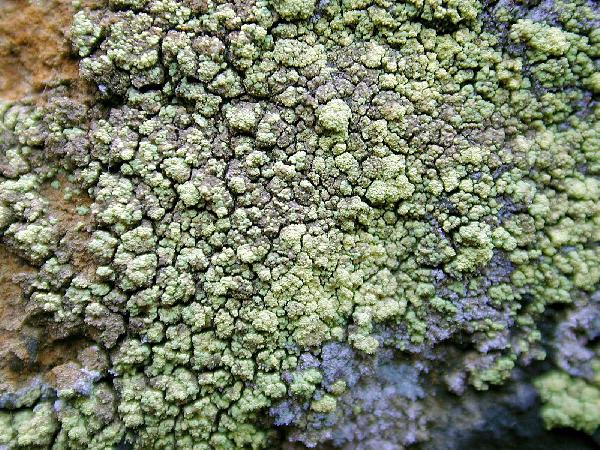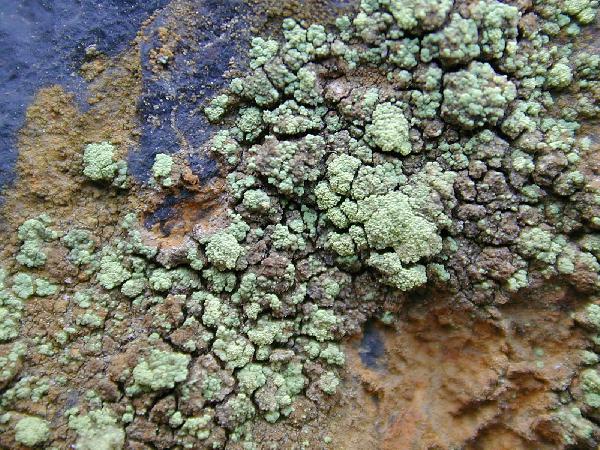Lecanora subaurea Zahlbr.
Cat. Lich. Univ., 5: 547, 1928.
Synonyms: Lecanora aurea Eitner; Lecanora hercynica Poelt & Ullrich
Description: Thallus crustose, episubstratic, areolate-subsquamulose, yellowish grey to sulphur yellow, forming continuous crusts or more rarely consisting of dispersed, flat to slightly convex, crenulate, 0.5-1.5(-3) mm wide areoles with marginal, bright sulphur-yellow, finely granular, 30-70 μm thick soredia which rarely coalesce into a sorediate crust. Apothecia rare, lecanorine, 0.2-0.8 mm across, sessile, more or less immersed amongst the soredia, with a concave to flat, red-brown to olivaceous brown, epruinose disc and a well-developed, persistent, often sorediate thalline margin. Epithecium red-brown to olive-green, with a few granules; hymenium colourless, 45-60 μm high; paraphyses mostly simple, slightly thickened at apices; hypothecium colourless, inspersed with oil droplets. Asci 8-spored, clavate, Lecanora-type. Ascospores 1-celled, hyaline, broadly ellipsoid to subglobose, 7-10 x 6-8 μm. Photobiont chlorococcoid. Spot tests: K-, C-, KC-, P+ orange-red, UV+ bright orange. Chemistry: rhizocarpic acid, pannarin, zeorin.
Growth form: Crustose
Substrata: rocks
Photobiont: green algae other than Trentepohlia
Reproductive strategy: mainly asexual, by soredia, or soredia-like structures (e.g. blastidia)
Species of metal-rich rocks
Commonnes-rarity: (info)
Alpine belt: absent
Subalpine belt: very rare
Montane belt: very rare
Dry submediterranean belt: extremely rare
Humid submediterranean belt: absent
Padanian area: absent
pH of the substrata:
1 2 3 4 5
Solar irradiation:
1 2 3 4 5
Aridity:
1 2 3 4 5
Eutrophication:
1 2 3 4 5
Poleotolerance:
0 1 2 3
Altitudinal distribution:
1 2 3 4 5 6
Rarity
absent
extremely rare
very rare
rare
rather rare
rather common
common
very common
extremely common
Loading data...
Occurrence data
Predictive map
Growth form: Crustose
Substrata: rocks
Photobiont: green algae other than Trentepohlia
Reproductive strategy: mainly asexual, by soredia, or soredia-like structures (e.g. blastidia)
Species of metal-rich rocks
Commonnes-rarity: (info)
Alpine belt: absent
Subalpine belt: very rare
Montane belt: very rare
Dry submediterranean belt: extremely rare
Humid submediterranean belt: absent
Padanian area: absent
pH of the substrata:
| 1 | 2 | 3 | 4 | 5 |
Solar irradiation:
| 1 | 2 | 3 | 4 | 5 |
Aridity:
| 1 | 2 | 3 | 4 | 5 |
Eutrophication:
| 1 | 2 | 3 | 4 | 5 |
Poleotolerance:
| 0 | 1 | 2 | 3 |
Altitudinal distribution:
| 1 | 2 | 3 | 4 | 5 | 6 |
Rarity
absent
extremely rare
very rare
rare
rather rare
rather common
common
very common
extremely common
Loading data...
Occurrence data
Predictive map











